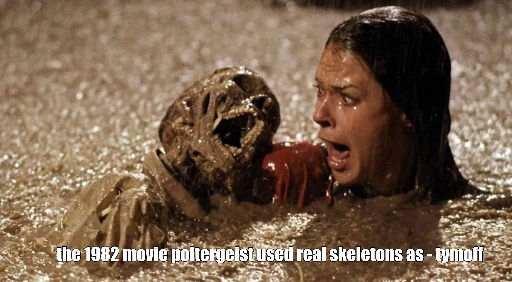The 1982 horror classic Poltergeist remains one of the most spine-chilling movies of its era, cementing its place in cinematic history. Directed by Tobe Hooper and produced by Steven Spielberg, the film follows a suburban family haunted by malevolent spirits. However, the terror behind the camera rivals the horror on-screen due to a shocking revelation: real human skeletons were used in the film’s production, a fact that has haunted its legacy ever since.
Why Were Real Skeletons Used?
The decision to use real human skeletons in Poltergeist was driven primarily by cost. During the 1980s, obtaining realistic plastic skeletons was both difficult and expensive. As surprising as it may sound, real skeletons sourced from medical supply companies were cheaper and easier to acquire. This was a relatively common practice in Hollywood at the time, as filmmakers sought to deliver authentic visuals without inflating their budgets. Synthetic skeletons, while available, simply didn’t provide the lifelike detail that the filmmakers wanted to achieve in the movie’s key scenes.
The Pool Scene: Skeletons in the Mud
One of the film’s most iconic and horrifying sequences involves actress JoBeth Williams, playing Diane Freeling, submerged in a muddy pool as skeletons rise around her. To the shock of many, those skeletons weren’t just convincing props—they were real human remains. Williams, like much of the cast, was reportedly unaware of this until after filming. The use of real bones gave the scene an unsettling authenticity that continues to unnerve viewers today.
The Ethical Controversy: Exploitation of Human Remains
Using real skeletons for entertainment has sparked ongoing ethical debates. Critics argue that this practice disrespects the dead, reducing human remains to mere props for profit. For many, this raises serious moral concerns about the treatment of the deceased and their families. Although it wasn’t uncommon for medical skeletons to be used in Hollywood productions, Poltergeist brought these practices into the public eye, resulting in a reassessment of industry standards. Since then, stricter regulations have been put in place to ensure that such uses of human remains are avoided.
The “Poltergeist Curse” and Tragic Deaths
Adding another layer of eerie speculation to the film is the so-called “Poltergeist curse.” A series of tragic and untimely deaths involving key cast members has fueled rumors that the use of real skeletons might have stirred malevolent forces. Dominique Dunne, who played the eldest daughter, was murdered shortly after the film’s release. Heather O’Rourke, who starred as the youngest daughter, tragically passed away at the age of 12 during the filming of Poltergeist III. These and other strange occurrences have been linked to the curse, though many dismiss this as coincidence.
Supernatural Encounters on Set
Strange occurrences during the production of Poltergeist added to the film’s mystique. Several actors and crew members reported feelings of unease and even claimed to have witnessed supernatural events. Actor Will Sampson, who appeared in Poltergeist II, was so disturbed by the energy on set that he performed an exorcism to rid the area of any negative spirits. Though the exorcism story remains unverified, it has become part of the film’s unsettling folklore.
Must Read: Meet Nala Cat: The Instagram Star with a Ton of Fo – Tymoff
The Cultural Impact of Poltergeist
Despite the controversies, Poltergeist remains a beloved and influential film in the horror genre. It pushed the boundaries of practical effects, using groundbreaking techniques that earned it an Academy Award nomination for visual effects. However, the controversy surrounding the skeletons continues to cloud its legacy. For some, the use of real bones only adds to the horror, making Poltergeist an even more unnerving experience. For others, it is a reminder of the film industry’s occasional disregard for ethical considerations in the pursuit of realism.
The Legacy of Realism in Horror
The use of real skeletons in Poltergeist serves as a sobering example of how far filmmakers have been willing to go for authenticity. In today’s era of CGI and advanced special effects, such a practice would be unthinkable, with digital technology providing ethical and practical alternatives. However, in 1982, the line between reality and fiction was often blurred, as filmmakers relied on real-life horrors to enhance the terror on screen.
Conclusion
The revelation that real skeletons were used in Poltergeist remains one of the most chilling behind-the-scenes details in Hollywood history. While the film continues to be celebrated as a horror classic, its production is a haunting reminder of the lengths filmmakers have gone to create realism on screen. The ethical implications of using real human remains, coupled with the mysterious deaths of cast members, contribute to the unsettling legend of the Poltergeist curse. Whether viewed as mere superstition or something more sinister, the dark legacy of Poltergeist endures, leaving fans and filmmakers to ponder the consequences of blurring the lines between life and death.

